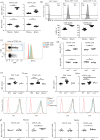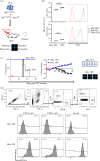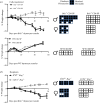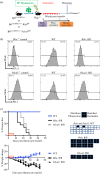Internal regulation between constitutively expressed T cell co-inhibitory receptors BTLA and CD5 and tolerance in recent thymic emigrants
- PMID: 39471840
- PMCID: PMC11521602
- DOI: 10.1098/rsob.240178
Internal regulation between constitutively expressed T cell co-inhibitory receptors BTLA and CD5 and tolerance in recent thymic emigrants
Abstract
Immunologic self-tolerance involves signals from co-inhibitory receptors. Several T cell co-inhibitors, including PD-1, are expressed upon activation, whereas CD5 and BTLA are expressed constitutively. The relationship between constitutively expressed co-inhibitors and when they are needed is unknown. Deletion of Btla demonstrated BTLA regulates CD5 expression. Loss of BTLA signals, but not signalling by its ligand, HVEM, leads to increased CD5 expression. Higher CD5 expression set during thymic selection is associated with increased self-recognition, suggesting that BTLA might be needed early to establish self-tolerance. We found that BTLA and PD-1 were needed post-thymic selection in recent thymic emigrants (RTE). RTE lacking BTLA caused a CD4 T cell and MHC class II dependent multi-organ autoimmune disease. Together, our findings identify a negative regulatory pathway between two constitutively expressed co-inhibitors, calibrating their expression. Expression of constitutive and induced co-inhibitory receptors is needed early to establish tolerance in the periphery for RTE.
Keywords: BTLA; CD5; T cells; autoimmunity; recent thymic emigrants; tolerance.
Conflict of interest statement
L.B. is CSO and board member at JJP Biologics, a company developing HVEM targeting approaches in oncology.
Figures







Similar articles
-
The BTLA-HVEM-CD5 Immunoregulatory Axis-An Instructive Mechanism Governing pTreg Cell Differentiation.Front Immunol. 2019 May 22;10:1163. doi: 10.3389/fimmu.2019.01163. eCollection 2019. Front Immunol. 2019. PMID: 31191536 Free PMC article. Review. No abstract available.
-
Thymic commitment of regulatory T cells is a pathway of TCR-dependent selection that isolates repertoires undergoing positive or negative selection.Curr Top Microbiol Immunol. 2005;293:43-71. doi: 10.1007/3-540-27702-1_3. Curr Top Microbiol Immunol. 2005. PMID: 15981475 Review.
-
Regulatory T Cell Dysfunction Acquiesces to BTLA+ Regulatory B Cells Subsequent to Oral Intervention in Experimental Autoimmune Encephalomyelitis.J Immunol. 2016 Jun 15;196(12):5036-46. doi: 10.4049/jimmunol.1501973. Epub 2016 May 18. J Immunol. 2016. PMID: 27194787 Free PMC article.
-
CD5 dynamically calibrates basal NF-κB signaling in T cells during thymic development and peripheral activation.Proc Natl Acad Sci U S A. 2020 Jun 23;117(25):14342-14353. doi: 10.1073/pnas.1922525117. Epub 2020 Jun 8. Proc Natl Acad Sci U S A. 2020. PMID: 32513716 Free PMC article.
-
N-Glycan Branching Regulates BTLA Opposite to PD-1 to Limit T Cell Hyperactivity Induced by Branching Deficiency.J Immunol. 2024 Nov 1;213(9):1329-1337. doi: 10.4049/jimmunol.2300568. J Immunol. 2024. PMID: 39269653
References
MeSH terms
Substances
Grants and funding
LinkOut - more resources
Full Text Sources
Molecular Biology Databases
Research Materials

